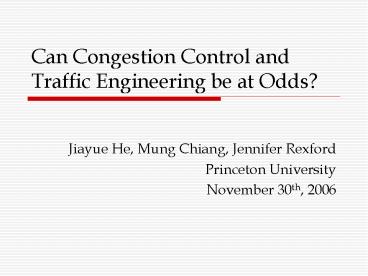Can Congestion Control and Traffic Engineering be at Odds? - PowerPoint PPT Presentation
Title:
Can Congestion Control and Traffic Engineering be at Odds?
Description:
Can Congestion Control and Traffic Engineering be at Odds? Jiayue He, Mung Chiang, Jennifer Rexford Princeton University November 30th, 2006 Motivation Congestion ... – PowerPoint PPT presentation
Number of Views:124
Avg rating:3.0/5.0
Title: Can Congestion Control and Traffic Engineering be at Odds?
1
Can Congestion Control and Traffic Engineering be
at Odds?
- Jiayue He, Mung Chiang, Jennifer Rexford
- Princeton University
- November 30th, 2006
2
Motivation
- Congestion Control
- maximize user utility
- Traffic Engineering
- minimize network congestion
Given routing Rli how to adapt end rate xi?
Given traffic xi how to perform routing Rli?
3
Congestion Control Model
Users are indexed by i
aggregate utility
Utility Ui(xi)
max. ? i Ui(xi) s.t. ?i Rlixi cl var. x
capacity constraints
Source rate xi
Congestion control provides fair rate allocation
amongst users
KellyMaullooTan98, Low03, Srikant04
4
Traffic Engineering Model
Links are indexed by l
aggregate cost
Cost f(yl/cl)
yl cl
min. ?l f(yl/cl) s.t. yl ?i Rlixi var. R
Link Load yl
Traffic engineering avoids bottlenecks in the
network
FortzThorup02, Rexford06
5
Model of Internet Reality
Congestion Control max ?i Ui(xi), s.t. ?i Rlixi
cl
xi
Rli
Traffic Engineering min ?l f(yl/cl), s.t. yl
?i Rlixi
6
System Properties
- Convergence
- Does it achieve some objective?
- Benchmark
- Utility gap between the joint system and benchmark
max. ?i Ui(xi) s.t. Rx c Var. x, R
WangLiLowDoyle05, HeChiangRexford06
7
Numerical Experiments
- System converges
- Quantify the gap to optimal aggregate utility
- Capacity distribution truncated Gaussian with
average 100 - 500 points per standard deviation
Access-Core
Abilene Internet2
8
Results for Access-Core
Homogeneous optimal
Aggregate utility gap
Utility gap can exist
Standard deviation
Homogenous capacity reduces gap
9
Results for Abilene
Aggregate utility gap
Gap exists
Standard deviation
10
Abilene Continued f n(yl/cl)n
Aggregate utility gap
n
Gap shrinks with larger n
11
Backward Compatible Design
- Simulation of the joint system suggests that it
is stable, but suboptimal - Gap reduced if we modify f
f(yl/cl)
Cost f
f(yl/cl)
yl cl
0
Link load yl
12
Theoretical Results
- Modify congestion control to approximate the
capacity constraint with a penalty function - Theorem modified joint system model converges if
Ui(xi) -Ui(xi) /xi
Master Problem min. g(x,R) - ?iUi(xi)
??lf(yl/cl)
Congestion Control argminx g(x,R)
Traffic Engineering argminR g(x,R)
13
Caveat
- Changing f allows for maximizing aggregate user
utility - Bottleneck links created
- Fragile to high volume traffic bursts
- Robustness lost
14
Conclusions So Far
- Model interaction between congestion control and
traffic engineering - Confirm intuition of the operators
- Stable
- Robust
- Modified joint system
- Optimal but not robust
15
New Objective
Congestion Control User Performance
Traffic Engineering Network Robustness
Can be at odds!
- To balance performance and robustness
- New objective max. ?iUi(xi) - ?lf(yl/cl)
16
Ongoing work
- DATE online distributed solution to new
objective - J. He, M. Bresler, M. Chiang and J. Rexford.
Towards Robust Multilayer Traffic Engineering"
In submission to JSAC Special Issue on
Cross-layer Traffic Engineering. - www.princeton.edu/jhe/
Congestion price
- Links
- Update prices
- Update effective capacity
- Edge router
- Rate limits incoming traffic
- Performs multipath routing
Link load
17
Future work
- Prove stability of joint system by modeling as a
two player game - Consider topology changes
- Link failures
- Mobile nodes
- Multi-domain version
18
The End
- Thank you!































